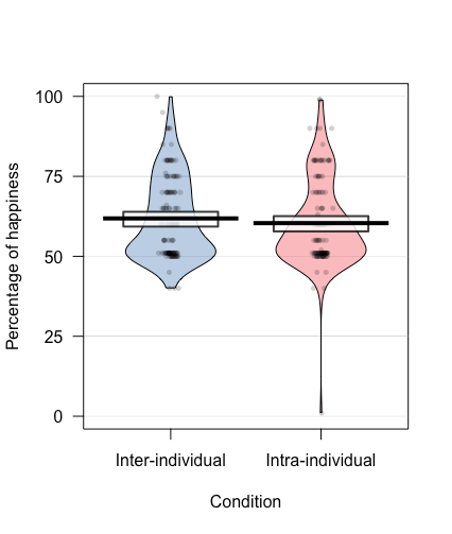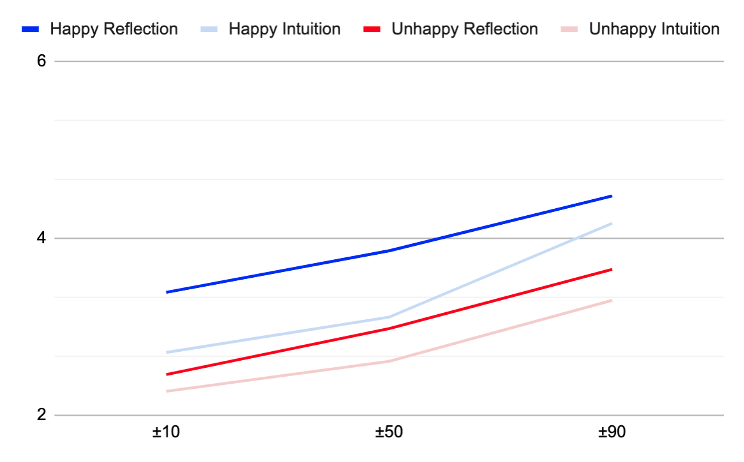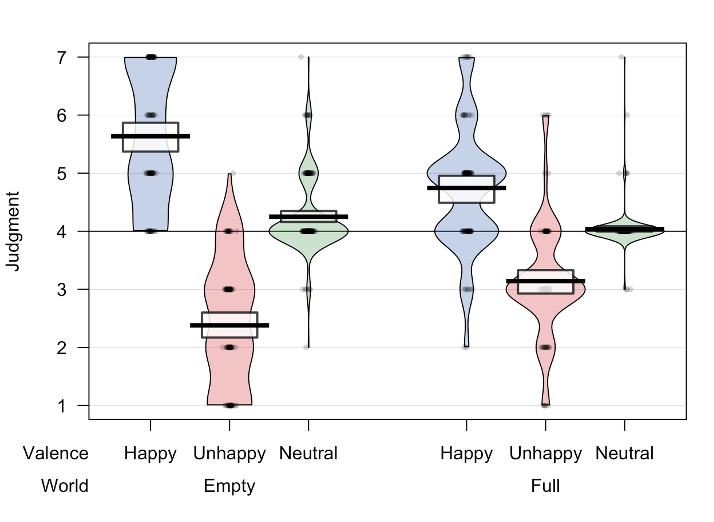In a new paper, David Althaus, Andreas Mogensen, Geoffrey Goodwin, and I, investigate people's population ethical intuitions. Across nine experiments (N = 5,776), we studied how lay people judge the moral value of hypothetical human populations that differ in their size and in the quality of the individual lives that comprise them. Our investigation aimed to answer three questions:
- Do people weigh happiness and suffering symmetrically?
- Do people focus more on the average or total welfare of a given population?
- Do people account only for currently existing lives, or also lives that could yet exist?
Here is a very brief summary of the key findings (more details can be found in the linked paper):
1. People, on average, weigh suffering more than happiness
Participants, on average, believed that more happy than unhappy people were needed in order for the whole population to be net positive (Studies 1a-c). Judgments about the acceptable proportion of happy and unhappy people in a population matched judgments about the acceptable proportion of happiness and unhappiness within a single individual’s lifetime. The precise trade ratio between happiness and suffering depended on the intensity levels of happiness and suffering, such that a greater proportion of happiness was required as intensity levels increased (Study 1b). Study 1c clarified that, on average, participants continued to believe that more happiness than suffering was required even when the happiness and suffering units were exactly equally intense. This suggests that people generally weigh suffering more than happiness in their moral assessments, above and beyond perceiving suffering to be more intense than happiness. However, our studies also made clear that there are individual differences and that a substantial proportion of participants weighed happiness and suffering equally strongly, in line with classical utilitarianism.

2. People have both an averagist and a totalist preference
Participants had a preference both for populations with greater total and greater average welfare (Study 3a-d). In Study 3a, we found that participants preferred populations with better total levels (i.e., higher levels in the case of happiness and lower levels in the case of suffering) when the average levels were held constant. In Study 3b, we found that participants preferred populations with better average levels when the total levels were held constant. In Study 3c, we found that most participants’ preferences lay in between the recommendations of these two principles when they conflict, suggesting that participants applied both preferences simultaneously in such cases. Further, their focus on average welfare even led them (remarkably) to judge it preferable to add new suffering people to an already miserable world, as long as this increased average welfare (Study 3d). But, when prompted to reflect, participants’ preference for the population with the better total welfare became stronger.

3. People value the addition of new people
Participants viewed it as good to create new happy people and as bad to create new unhappy people (Studies 2a-b). This means that people do not endorse the so-called intuition of neutrality according to which creating new people with lives worth living is morally neutral. Moreover, we also found that people’s judgments about the positive value of adding a new happy person and the negative value of adding a new unhappy person were roughly symmetrical. That is, their judgments did not reflect the so-called asymmetry—according to which adding a new unhappy person is bad but adding a new happy person is neutral. It is surprising that people’s judgments about adding a new happy or unhappy person were symmetrical given that they weighed suffering more than happiness when asked about the appropriate proportion of happy vs. unhappy people in a population in Studies 1a-c (and we discuss possible explanations in the paper).

To our knowledge, this is the first empirical investigation of people's population ethical intuitions in the academic psychological literature (see Dean Spears' related research (1, 2) in economics). We hope this paper could trigger more psychological research in this domain.

I found this paper really interesting - so, thanks!
Two questions and a comment
First question: in broad terms, what do you think moral philosophers should infer from psychological studies of this type in general, and from this one in particular? One perspective would be for moral philosophers to update their views towards that of the population - the "500 million Elvis fans can't be wrong" approach.
This is tempting, except that the views of the average person appear inconsistent (ie they weigh suffering more but also think creating neutral lives is good) and implausible, by the lights of views amongst philosophers (eg those surveyed believe adding unhappy lives can be good where it increases average happiness). Even if the views were coherent and plausible (eg those surveyed congregated on a single, consistent view) it would still seem open to philosophers to discount the views of non-experts who hadn't really familiarised themselves enough with the literature and so did not constitute epistemic peers.
Second question: for the adding people experiment, how confident should we be that those surveyed were thinking solely about the value of adding the new person, as it relates to that person themselves, and not instead thinking about the effects adding a life has on other people? In skimming the paper, I couldn't see anything about how you had tested the participants were answered the right question.
I ask because, when I speak to people about the value of adding new lives, it is incredibly hard to get people to think just about the value related to the created individuals, and not that person's parents, society, etc. Yet, to find out their views on population ethics, people need to realise they are just thinking about the effects regarding the created individual themself only. Of course, I might say that adding a happy life is very good, but that's just because I am thinking it is good for the parents, etc.; conversely, I could answer that adding unhappy lives are bad because they are a drain on others. If I do this, I wouldn't have answered the question you want me to. As such, it's not clear to me your experiment has really tested what you said it has.
A comment: in the one about adding lives, you describe the populations as 'empty' and 'full'. This is confusing, as in the paper 'empty' actually means 1 millon people, not an actually empty world; 'full' means 10 billion (which is questionably 'full', either). I think you should flag this more clearly and/or use different terms. 'Small' and 'large' might be better. I can imagine people having different intuitions if there are genuinely no people existing at the time, and also if the world seems more genuinely full, eg had 100 billion people.
Thanks, these are great points!
As for your first question about the philosophical implications of this psychological research: In general, the primary goal of our project was a descriptive one and it would require a separate project (ideally lead by philosophers) to figure out what the possible normative implications are. I also believe that we need much more empirical research to understand in greater detail what exactly the psychological mechanisms are that drive people's population ethical views. I see this as a very first exploration.
That said, I agree with much of what Jack says in the other comment. We should be cautious in simply accepting lay people's intuitive reactions to these tricky moral dilemmas or even making our policies based on them. Most people's reactions are very uninformed (most have never thought about these questions before), their reactions are often inconsistent, framing-dependent and — as we saw in some of our studies — people themselves tend to revise their opinions after more careful reasoning.
At the end of our paper, we say:
As for your second question about the adding-people experiment (Studies 2a-b): You are right that participants may misinterpret our dilemmas and questions. This is a general issue with studying such abstract questions and we tried our best to make things as clear as possible to people. In most studies, for example, we double checked if people understood and accepted our assumptions (and excluded participants from the analyses who have failed these checks).
In Studies 2a-b, the question we asked was "In terms of its overall value, how much better or worse would this world (containing this additional person) be compared to before?" (1 Much worse - 7 Much better). Even though this seems pretty clear to me, I think you're right that it's possible that some participants also considered the indirect effects on other people it would have to add a new person. One reason why I believe our finding would largely stay the same, even if we ensured that participants did not take the indirect effects into account, is the empty world condition in Study 2b. (And this relates to your comment.) In Study 2b, we indeed had a condition where the initial world contained zero people (empty world) and another condition where the initial world contained 10 billion people (full world). And even in the empty world condition, where you'd expect such indirect-effect considerations to be ruled out, we still find the same pattern. (That being said, I believe it's possible that a different question and different framing could yield different results.)
Regarding your comment, let me clarify: in Study 2a, the initial world contained 1 million people, but in Study 2b we tried to replicate this effect with a scenario where the initial world contained either zero people or 10 billion people. I believe this should be described correctly in the paper (if not, please let me know). But I noticed that there was an incorrect paragraph in our supplementary materials, which may have lead to this confusion and which I've now fixed (Thanks for making me aware of it!).
Thanks for this answer! It was really helpful. I hadn't spotted that the 'empty world' really was empty in the experiment; not sure how I missed that.
I know this wasn't directed at me but I have a few thoughts.
I think there are various useful things one can take from this study. A few main ones off the top of my head:
With regards to your second question and comment I think you make fair points.
Most disagreements between professional philosophers on population ethics come down to disagreements about intuition:
But none of them ultimately have any justification beyond their intuition. So I think it's totally fair and relevant to survey non-philosophers' intuitions.
Well, all disagreements in philosophy ultimately come down to intuitions, not just those in population ethics! The question I was pressing is what, if anything, the authors think we should infer from data about intuitions. One might think you should update toward people's intuitions, but that's not obvious to me, not least when (1) in aggregate, people's answers are inconsistent and (2) this isn't something they've thought about.
It's notable that a pilot study (N = 172, compared to N = 474 for the results given in Fig. 1) discussed in the supplementary materials of this paper suggests a stronger suffering/happiness asymmetry in people's intuitions about creating populations. e.g. In response to the question, “Suppose you could push a button that created a new world with X people who are generally happy and 10 people who generally suffer. How high would X have to be for you to push the button?”, the median response was X = 1000.
Thanks for this interesting post. A request/suggestion: the graph of section 2 in this article could be explained more clearly. Though I read the caption a couple of times, I still don't understand what the scores on the axes mean exactly. If this is a popular post, I'd consider clarifying.
"Participants.
We recruited 431 US American participants online via MTurk ($0.35 payment per participant). 75 were excluded, leaving a final sample of 356 people (170 female, M age = 38.46, SD age = 11.20). We aimed to recruit at least 400 participants to account for any exclusions. Sample size was determined before data collection"
It is interesting to see people preferring to have a higher variance in welfare (implication of q2), however it could also be related to the US culture of having a large inequality (which may or may not be a good thing).
Do you have plans to repeat this work for other cultures, like Europe or even further apart like Indonesia?
I don't think our findings suggest that people have a preference for populations with higher variance in welfare (i.e. greater differences in how how happy they are). All else equal, people probably have a strong preference for fair welfare distribution (even in the US). But sometimes they may choose the option that contains more welfare variance because this population has a higher average or total level (or for some other reasons).
I agree with you that it would be very interesting to do a cross cultural study. I don't have a specific hypothesis about cross cultural differences though. Note that there already exists some cross cultural research on fairness and prosocial behavior.